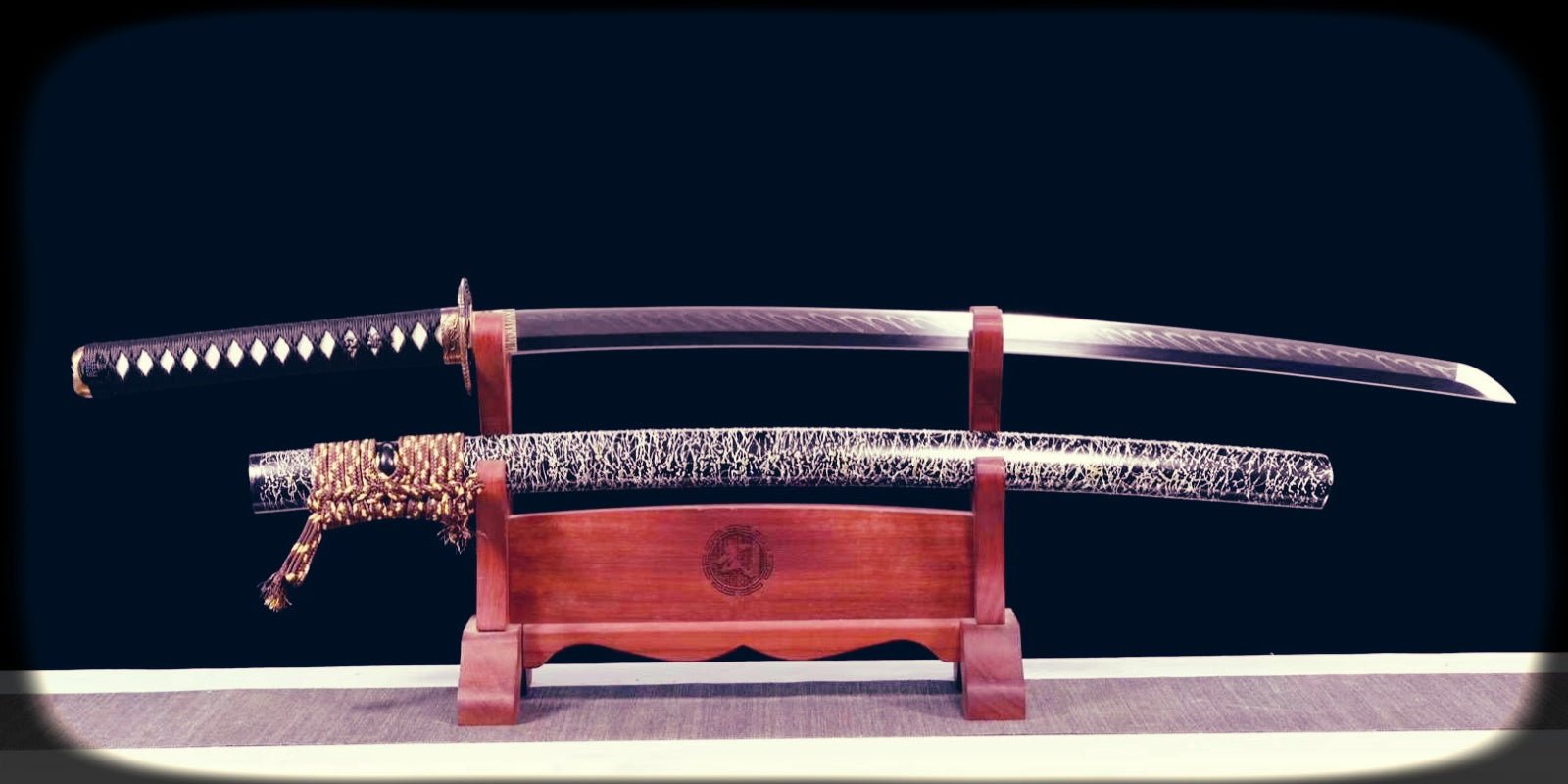Introduction to Hamon: The Soul of the Samurai Sword
The hamon, the distinctive temper line seen on the blade of a katana, represents more than just ornamental beauty—it encapsulates the swordsmith’s craftsmanship and the blade’s functional essence. This intricate feature is born from the tempering process, where the edge is hardened differently from the spine. Its appearance varies based on the clay application, cooling techniques, and the smith's intent.
Hamon patterns showcase artistic expression, including styles such as straight (suguha), undulating (choji), and wave-like (notare). These designs provide insight into the traditions of specific schools or regions, revealing lineage and the smith’s mastery. Beyond aesthetics, it reflects the blade's durability and cutting effectiveness.
The Art and Science Behind Hamon Creation
The creation of a hamon is both a meticulous art and an exact science, reflecting the swordsmith’s expertise and intention. This visual hallmark emerges during the differential hardening process, where clay is meticulously applied to control the steel’s temperature during quenching. The blade’s edge is left exposed to cool rapidly, enhancing hardness, while the spine cools more slowly, preserving flexibility.
Key factors influencing hamon design include the type of steel used, the clay mixture's composition, and the quenching medium. Hamon patterns range from straight (suguha) to intricate waves (choji-midare), each signifying the swordsmith's technique and cultural significance. Professional precision determines the resulting aesthetics and durability.
Historical Significance of Hamon in Japanese Swordsmithing
The hamon, a distinct crystalline line on a Japanese katana, holds deep historical importance within the ancient art of swordsmithing. It serves as a visible testament to the meticulous craftsmanship and thermal expertise of Japanese swordmakers, reflecting centuries-old techniques. Dating back to the Heian period, its presence originally signified functional qualities essential for combat, such as hardness and flexibility. Historically, each region in Japan developed its unique hamon patterns, which became identifiers of specific swordsmithing traditions. This intricate feature also played a role in showcasing the artisan's skill and dedication to perfection, which were highly revered in the samurai culture.
Types of Hamon Patterns: Exploring Their Diversity
Hamon patterns, an artistically distinctive aspect of a katana, reflect the skill and creativity of the swordsmith. These patterns are the visible results of the tempering process and vary based on the clay application and cooling techniques. Common types include:
- Suguha (Straight): A simple, straight hamon highlighting precision and consistency.
- Notare (Wavy): Smooth, wave-like patterns symbolizing fluidity.
- Gunome (Rounded): Alternating semi-circular humps signaling complexity.
- Choji (Clove Pattern): Intricate, clove-shaped curves showcasing an ornate aesthetic.
- Hitatsura (Full-Temper): A dramatic, irregular hamon over the entire blade, requiring advanced craftsmanship.
Each pattern not only enhances visual appeal but also represents specific functional and cultural practices linked to the sword’s origin.
How Hamon Reflects the Swordsmith's Skills and Philosophy
The hamon on a katana serves as a physical manifestation of the swordsmith’s mastery and artistic vision. It reveals the level of precision in controlling heat treatment during the forging process. By selectively tempering the steel, the smith balances the blade’s hardness and flexibility—essential traits in functional weaponry. The hamon’s pattern also reflects the philosophical values of the craftsman. Traditional styles might express adherence to heritage, while experimental designs may demonstrate innovation. The intricate curves, waves, or subtle transitions in a hamon can symbolize nature, harmony, or strength, embodying the ethos of the swordsmith in tangible form.
Hamon as a Signature: The Mastery of Individual Swordsmiths
A katana’s hamon serves as a reflection of the swordsmith’s artistry, skill, and individual style. Each hamon is meticulously crafted through specific processes, such as heating and quenching, which are heavily influenced by a swordsmith’s preferences and expertise.
Different patterns, including choji-midare, gunome, and suguha, are intentional signatures, each unique to a smith or school of craftsmanship. These patterns reveal not only aesthetic choices but also functional considerations, such as blade flexibility and cutting strength.
By analyzing the hamon, experts can trace lineages of swordsmithing traditions, connecting modern blades to their historical influencers. This signature encodes centuries of technique and innovation.
The Role of Heat Treatment in Hamon Formation
Heat treatment plays a pivotal role in crafting the hamon, the aesthetic and functional hallmark of traditional katanas. Controlled differential hardening is employed, where clay coating is applied before heating. Swordsmiths carefully regulate temperature to transform steel’s microstructure. The edge, heated to a higher degree, cools rapidly during quenching, forming martensite for sharpness. The spine cools slower, retaining softer pearlite, essential for resilience. The interaction between these properties yields the hamon, with its distinctive contours and patterns. Variations in clay thickness, heating duration, and quenching technique directly influence the hamon, showcasing the meticulous craftsmanship ingrained in the blade’s legacy.
Cultural Symbolism Embedded in Hamon Styles
Hamon styles transcend their functional role, embodying profound cultural and spiritual significance within Japanese swordsmanship. Each pattern speaks to regional traditions, aesthetics, and philosophical ideals. For example, the choji-midare style, resembling clove blossoms, symbolizes renewal and balance, aligning with natural harmony in Japanese culture. Similarly, the notare style, with its flowing waves, grounds itself in fluidity and resilience, mirroring life's uncertainties and adaptability.
Swordsmiths often infused their work with their personal beliefs, reflecting samurai values like honor and perseverance. These styles were not merely decorative but carried generational legacies, often distinguishing particular schools of craftsmanship or clan alliances.
Modern Interpretation and Application of Hamon Patterns
In contemporary sword-making and collecting, hamon patterns transcend their original utilitarian purpose to become a pivotal design aesthetic. Modern smiths meticulously craft these patterns using differential heat treatment to create visual harmony while maintaining the blade's functionality. The choice of a hamon often reflects a blend of traditional techniques and innovative approaches.
- Artistic Expression: Today, hamon patterns, such as notare or choji, are chosen to exhibit a smith's technical expertise and artistic vision.
- Blade Collecting: Enthusiasts value unique hamons as markers of authenticity and craftsmanship.
- Functional Adaptation: Despite their decorative appeal, hamons signify hardened edges that preserve the blade's sharpness for practical use.
Such patterns bridge a connection between ancient traditions and modern craftsmanship.
Preserving the Legacy: Collecting and Studying Traditional Hamons
The study and collection of traditional hamons serve as a gateway to understanding the artistry and techniques of historical swordsmiths. Collectors and enthusiasts examine subtle details within a hamon, such as its curvature, consistency, and intricacy, to trace the lineage of a blade or authenticate its origin. These temper lines are often preserved as cultural artifacts, reflecting the unique regional styles of ancient Japan.
Efforts to preserve these blades involve proper care, including controlled humidity levels, expert polishing, and the avoidance of harsh chemicals. Documenting hamons through high-quality imaging or detailed sketches contributes to efforts in conserving these invaluable legacies for future generations.
Conclusion: What Hamon Reveals About the Swordsmith's Vision
The hamon on a katana is far more than a decorative feature; it is an enduring testament to the swordsmith's mastery and artistic intent. Each curve, ripple, or straight line reflects meticulous choices made during the forging and tempering processes. The pattern of the hamon often showcases the swordsmith's unique approach to balancing durability and flexibility in the steel, illustrating technical prowess blended with artistic expression. Furthermore, the type of hamon chosen can reveal cultural influences or regional traditions that shaped the smith’s philosophy. Ultimately, the hamon acts as a tangible imprint of the swordsmith’s vision for an enduring blade.

